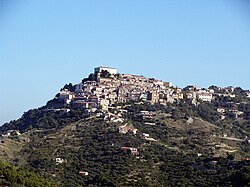Castellabate
This article needs additional citations for verification. (August 2018) |
Castellabate | |
|---|---|
| Comune di Castellabate | |
 View of Castellabate. | |
| Coordinates: 40°17′N 14°57′E / 40.283°N 14.950°E | |
| Country | Italy |
| Region | Campania |
| Province | Salerno (SA) |
| Frazioni | Alano, Licosa, Ogliastro Marina, Santa Maria, San Marco |
| Government | |
| • Mayor | Costabile Spinelli |
| Area | |
| • Total | 36 km2 (14 sq mi) |
| Elevation | 289 m (948 ft) |
| Population (30 June 2017)[2] | |
| • Total | 9,181 |
| • Density | 260/km2 (660/sq mi) |
| Demonym | Castellani or Caatellabatesi |
| Time zone | UTC+1 (CET) |
| • Summer (DST) | UTC+2 (CEST) |
| Postal code | 84048 |
| Dialing code | 0974 |
| Patron saint | St. Costabile |
| Saint day | February 17 |
| Website | Official website |
Castellabate (Cilentan: Castiellabbate) is a town and comune in the province of Salerno in the Campania region of south-western Italy.
History
The area was inhabited since Upper Palaeolithic times. In early medieval times, the current frazione of Licosa was a base of the Saracens, who were defeated here in 846 by a coalition of the Duchy of Naples, Amalfi, Sorrento and Gaeta.
The history of the current Castellabate is tied to Saint Costabile Gentilcore (St. Constabilis), fourth abbot of La Trinità della Cava. In 1123, the same year in which he was elevated to the position of abbot, he started construction on the Angel's Castle (10 October 1123), which afterwards became entitled to him. His title gave the village its present name: Castrum Abbatis, Latin for "the castle of the abbot". His abbacy lasted until 17 February 1124. His successor, Simeon, completed its construction and helped the inhabitants.
Later, Castellabate fell under the control of the barony of the Cilento. It then passed, in turn, to Caracciolo, Loffredo, Filomarino, Acquaviva, and finally the Granito family (who carried the title of marquis and later became princes by marriage) in 1745. Castellabate remained in the family of the Prince of Belmonte until the end of the feudal era.
Geography
Castellabate borders with the municipalities of Agropoli, Laureana Cilento, Montecorice and Perdifumo. It counts the hamlets (frazioni) of Alano, Licosa, Ogliastro Marina, Santa Maria (the municipal seat) and San Marco; and the localities of Lago and Tresino.
Transport
The nearest railway station is found at Agropoli. Served by numerous trains, which include Eurostar Italia, it is found on the route of Naples-Reggio Calabria. In terms of roads, it is served by the A3 Highway, which connects the town with the coast of Cilento.
Access by sea is found at the port of San Marco di Castellabate.
Cuisine
Castellabate's cuisine is based on local products: wine, olive oil, cheese (such as mozzarella), garbanzo beans, salami, and confections made with figs.
Media
Benvenuti al Sud,[3] an Italian adaptation of the 2008 French film Bienvenue chez les Ch'tis, is set in Castellabate and partly in its hamlets Santa Maria and San Marco.[4]
International relations
Castellabate is twinned with:
 Blieskastel, Germany, since 2008
Blieskastel, Germany, since 2008
See also
References
- ^ "Superficie di Comuni Province e Regioni italiane al 9 ottobre 2011". Italian National Institute of Statistics. Retrieved 16 March 2019.
- ^ "Popolazione Residente al 1° Gennaio 2018". Italian National Institute of Statistics. Retrieved 16 March 2019.
- ^ Benvenuti al Sud at IMDb
- ^ Template:It icon Article on the Corriere del Mezzogiorno
External links
- Tourism in Castellabate and in the National park of Cilento
- Cilento and Vallo di Diano National Park Template:It icon Template:En icon
- Blue Flag[permanent dead link]




